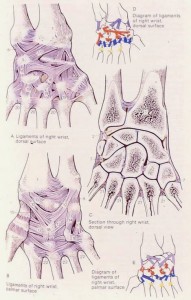Healthy Life: Sprained Wrist – Causes and Symptoms (579)
Healthy Life: Sprained Wrist
蘇鎮邦 (Christopher So):
舒整物理治療師 (Manipulative Physiotherapist) 人類工程師 (Ergonomist)
A sprained wrist is one of the most common wrist injuries and usually involves tears of the ligaments (see diagram) with pain in most wrist movements. The thumb, index and middle fingers form the dynamic tripod for fine grip and movements for writing, fine painting, surgery and sculpture. This distinguishes us from the apes as they lack opposition movements between the thumb and other fingers. They are not designed for forceful movements which involve the ring and little fingers in a power grip or hammer grip.
When falling on the wrist which has to take up the weight of the body plus the momentum, ligaments around the wrist will be torn depending the direction of the fall or points of impact. In particular, if the fall involves any rotational or torsional wrist movements, a severe sprain of the wrist will result.
As humans do not rely on the arms to bear weight when walking, the muscles and bones in the arms are relatively smaller and weaker. Particularly during pregnancy, a female undergoes hormonal changes which will weaken the ligaments in the body. The aim is to allow the pelvic ligament, especially the pubis symphysis, to separate and allow the baby to come out. However, the hormonal changes will affect all the ligaments in the body. In addition, after the delivery the mum needs to carry or hold the baby in activities such as feeding and bathing. These activities will add unnecessary strain to the already weakened wrist ligaments. Painful wrist or tenosynovitis is very common.
In the early stage, the wrist will become painful after a day’s work. Then, pain is felt during work. The final stage is pain even during rest and sleep. The common activities that can cause wrist pain include feeding, carrying a baby, wringing towels, brushing teeth, turning the steering wheel, turning keys, opening caps, frying vegetables, cleaning tables, washing dishes and ironing.
Physiotherapy or manual treatment will aim at the affected ligaments and painful movements. It aims to restore the normal range of movement to pain free stage. Ultrasound and interferential therapy will increase the recovery process. Finally, appropriate types and amount of exercises will help to attain full recovery.

A,D Ligaments of the dorsal side B,E palmer side of the hand
